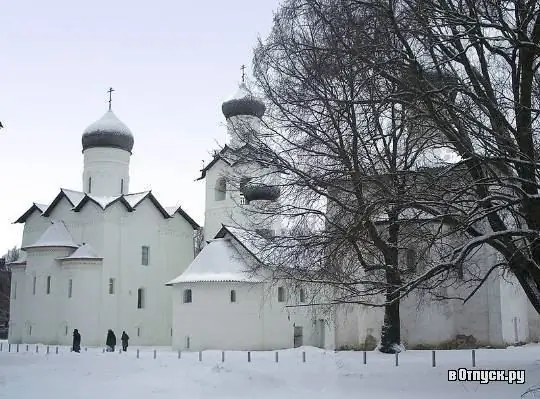
Description of the attraction
The Museum of Local Lore of the town of Staraya Russa is a branch of the Novgorod State United Museum-Reserve and is located on a large square named after Timur Frunze, in several buildings of the large Spaso-Preobrazhensky Monastery. The Cathedral of the Transfiguration of the Savior is the oldest temple in the city. Its construction was carried out in 1198. Only the lower parts of the walls with some fragments of unique fresco paintings from the late 12th century have survived from the original building of the temple to this day. At the moment, the church has been restored in the form of the 17th century.
The opening of the Old Russian Museum of Local Lore took place in the fall of September 19, 1920. The museum exposition at that time consisted of several departments: archaeological, natural history and art. The basic part of all the collections were items of important museum value, obtained from the nationalized estates of Count Bennisgen, Prince Vasilchikov and some other landowners of the city.
During 1933, the museum was transferred to the Cathedral of the Resurrection of the Lord, which was brutally plundered by the Nazis during the war. In the winter of 1964, it was decided to open a local history museum in the building of St. Nicholas Church, which was carried out on a voluntary basis. It was in 1966 that the museum became a branch of the Novgorod Museum-Reserve.
At one of the exhibitions entitled "Finds of Archaeologists" museum exhibits are exhibited, found during excavations in 1967-1974, which were led by the candidate of historical sciences, as well as the USSR Honorary Prize winner A. F. Medvedev. Considering objects of the 11-15th centuries, you can learn more about the life of the medieval town of Staraya Russa, whose history goes back thousands of years. The exhibition contains truly unique products of its kind by ancient craftsmen, made of wood, bone, metal, and you can also trace the trade relations of Russa with Scandinavia and Byzantium.
In the museum you can get acquainted with the historical development of the Spaso-Preobrazhensky monastery, as well as local monasteries; the theme of the life of monks, city shrines is especially considered in this section. Of particular interest is the so-called reconstruction of a monastic cell dating back to the Middle Ages; you can examine in detail the real monastic vestments and various church utensils.
For many years, the museum had an exhibition dedicated to the theater and literature of Staraya Russa, which contained important documents and materials about the city's resort theater and writers. To date, the exposition has been removed.
The presented art gallery occupies the premises of the Meeting of the Temple, located slightly away from the temple complex. It is worth noting that during the Great Patriotic War, a fairly large number of exhibits of the art gallery dating back to 1922 were lost; unfortunately, the exhibits were never found. During the 1960s, it was planned to revive the former art gallery in the city, while it was decided to create a gallery consisting of paintings by fellow countrymen. Soon, in 1964, the first visitors to the art gallery of Staraya Russa were received. Since the past, everything has changed very much, including not only the works themselves, but also the design and decoration of the premises, although the specific division of the presented exposition remained the same. The upper hall housed the works of the famous artist Svarog V. S.- an amazing master of watercolor painting, whose name and creative activity have been unjustly forgotten for many years. In the lower hall there are works of the talented artist Pevzner T. I., as well as other fellow countrymen - Ushakov V. V., Lokotkov N. M., Kuznetsov N. A. and sculptor Tomsky N. V.
In addition to exhibition and fund work, the museum staff are actively involved in educating the younger generation, working on the socio-cultural project "Peace to Children". The museum closely cooperates with educators and teachers of children's institutions throughout the city.






